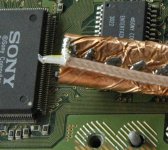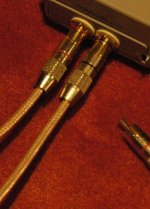planet10 said:
I've not used as speaker wire -- too fiddly. AW is indeed one of those 2 gurus. He taught me about tube amps and i helped him out with his Macs.
dave
Thanks dave,
I was thinking single runs for each of the + and – post using ~26-30awg for a small widerange as internal speaker wiring. I believe some wire wrap wire are stranded but most are solid. AW has been helpful to me too in the past wrt tube circuits..
I've tried 24awg braided magnet wire (poly coated) as RCA IC's (from source to amp) without any sleeving or damping and they were microphonic. When damped with some cotton inside a polyester sleeve the mircrophony was tamed, this was too fiddly to do though even with short lengths. I was wondering if that would also be the case when used as single runs for internal speaker wiring without any sleeving. Anyone tried it?
IIRC TNT audio do something similar, albeit in their case it's an interconnect: http://www.tnt-audio.com/clinica/shoestrings_e.html
happy.gringo said:How about long shoestrings as insulation? Should be fairly easy to thread them.
I have my cotton shoelaces (make sure they are cotton -- a match to the end lets you know pretty quick), my radio shack wire wrap wire, and super cheapo RCAs, and some teflon tube (for the centre) just sitting for a rainy winter day, and i'll make up some interconnects.
dave
Scottmoose said:IIRC TNT audio do something similar, albeit in their case it's an interconnect: http://www.tnt-audio.com/clinica/shoestrings_e.html
I have some of the same Teflon tube they used in that out of some RG-xx i got gifted on me... makes a VERY stiff interconnect.
BTW, that is pretty much AW's receipe there (except for the much thicker wire) and what i'm planning
dave
Don't bother with shoelace based interconnects.
Use normal RG59 or teflon RG179 for your interconnects. The highly regarded ICs all have low capacitance. 75 ohm coax is ideal. It's screened and has similar specs to the shoestring cables with the added benefit of costing cents per metre and being ready-made.
I've used teflon insulated RG58 equivalent (50 ohm) and it's too stiff and the capacitance is slightly higher than 75 ohm coax.
Even better are car stereo antenna extension cables, these are 93 ohm coax with even lower capacitance. The downside is the inner wire is so fine it starts making termination difficult.
RG179 is nice and thin and being teflon insulated can be very enthusiastically soldered. Here is a bit used for a PS mod on a screened capacitor.
Use normal RG59 or teflon RG179 for your interconnects. The highly regarded ICs all have low capacitance. 75 ohm coax is ideal. It's screened and has similar specs to the shoestring cables with the added benefit of costing cents per metre and being ready-made.
I've used teflon insulated RG58 equivalent (50 ohm) and it's too stiff and the capacitance is slightly higher than 75 ohm coax.
Even better are car stereo antenna extension cables, these are 93 ohm coax with even lower capacitance. The downside is the inner wire is so fine it starts making termination difficult.
RG179 is nice and thin and being teflon insulated can be very enthusiastically soldered. Here is a bit used for a PS mod on a screened capacitor.
Attachments
And here is the RG400 (rg58 equivalent).
Ordinary RG59 should be better, but the silver plated copper with the double braid is very... bling. I couldn't resist it. You could drive a truck over these.
RG179 specs, pricey, Group buy? I challenge anyone to find better cost/performance at a similar quality.
http://www.rsaustralia.com/cgi-bin/...cdfaddlmekjmlhcefeceeldgkidhgm.0&cacheID=auie
Ordinary RG59 should be better, but the silver plated copper with the double braid is very... bling. I couldn't resist it. You could drive a truck over these.
RG179 specs, pricey, Group buy? I challenge anyone to find better cost/performance at a similar quality.
http://www.rsaustralia.com/cgi-bin/...cdfaddlmekjmlhcefeceeldgkidhgm.0&cacheID=auie
Attachments
I made new 10 ft runs using one conductor in two separate cat5 bundles. Again it gave me a big improvement. Bass is a little better but the clarity of the sound is what surpised me most. I thought everything sounded clear before. It sounds like Bjork is in the room with me. I continue to be amazed by the capabilty of the FE126 drivers.
I was concerned about one conductor with the weight of the entire cable hanging from it. I found Monster Quick Lock Gold Flex Pin Connectors at Rat Shack and they fit the bill. My sheilded cable gave me a nice interference fit into the opening in the back of the cable so no wieght is on the single conductor. They are expensive in my opinion but well worth it to not have to rig something.
I was concerned about one conductor with the weight of the entire cable hanging from it. I found Monster Quick Lock Gold Flex Pin Connectors at Rat Shack and they fit the bill. My sheilded cable gave me a nice interference fit into the opening in the back of the cable so no wieght is on the single conductor. They are expensive in my opinion but well worth it to not have to rig something.
After reading every single post on here, it is clear what must be done inside the new boxes being glued in the garage. The big question is, what if you need to run a 30ft length of cable. Romex? Double or tripple strands of cat5 twisted? 18ga Zip cord?
I would like to add to an earlier post. Even considering this does seem dirty and against everything even learned. A conversation about skin effect, wires, and amps did come up while in school, and the book and instructor had different thoughts.
I would like to add to an earlier post. Even considering this does seem dirty and against everything even learned. A conversation about skin effect, wires, and amps did come up while in school, and the book and instructor had different thoughts.
my usual advice:- put the amps next to the speaker and the question does not arise.zayne742 said:The big question is, what if you need to run a 30ft length of cable. Romex? Double or tripple strands of cat5 twisted? 18ga Zip cord?.......
Tiny currents through the line level interconnects are much less affected by conductor impedances due to the finite output impedance of the source. But, keep it low, 20r to 100r if possible.
That would be ideal, and is on the two in the front of the room, near the amp, but the two in the back pose a different scenario. The shortest route will be used, but still looks like 20-25 ft.
zayne742 said:A conversation about skin effect, wires, and amps did come up while in school, and the book and instructor had different thoughts.
Nothing new there then. 🙄
On the up-side, you can at least forget about skin effect: it's all but irrelevant at audio frequencies.
If you want a slightly resistive wire, I'd be inclined to use something around 20ga over that distance. Thinner would be pushing it a bit. According to my wire calculator (assuming it's accurate -I'm too lazy to do the math) DC resistance of typical copper over that length (sum of positive & negative, so 60ft total) is about 1.2ohms. You could make a slightly thicker cable using 3 24ga conductors each for positive & negative, which gives about 19.25ga and slightly over 1ohm of resistance for the total wire length.
Depends on your speaker / amp combination as to what will suit best. If they're already well balanced, there's little to be gained from using resistive wire, (aside from possibly reducing back-interference from the speaker getting into the amp's output stage, if you buy into that notion), though you'd probably get some benefit simply shifting to solid core though, so I'd just get down the local hardware store and buy a spool of solid core twin & earth of about 14ga, or heavier if possible. If you really wanted to go to town with that, remove the PVC jacket, and twist 4 of the conductors together, paralleling two for each run in a star-quad configuration for a good, low resistance wire, with excellent RFI rejection characteristics. Be pretty stiff of course.
Hi Scott,
if you were building a starquad speaker cable from mains solid core, how many twists per foot would you use for 1.5sqmm?
Would that change if you used 1sqmm or 2.5sqmm?
Now the really big question; have you an easy way to carry out the bundling/twisting when the required length of these cables becomes unwieldy?
if you were building a starquad speaker cable from mains solid core, how many twists per foot would you use for 1.5sqmm?
Would that change if you used 1sqmm or 2.5sqmm?
Now the really big question; have you an easy way to carry out the bundling/twisting when the required length of these cables becomes unwieldy?
Scottmoose said:
Nothing new there then. 🙄
On the up-side, you can at least forget about skin effect: it's all but irrelevant at audio frequencies.
That was somewhat my point, just that at that time the idea of using solid core wire seemed absurd. And now it seems to be the best solution. Yet, the notion was raised that if the electrons flowed on the outside of the wire, and essentially ran as a sporadic AC signal, would groupings of the wire in a tight pack degrade the signal by the electrons attracting, opposing, or crashing into each other. This may or may not be the case, seems logical nonetheless.
May go ahead and run equal lengths of the cat 5, romex, and basic zip just for experimental purposes and report back the findings.
AndrewT said:Hi Scott,
if you were building a starquad speaker cable from mains solid core, how many twists per foot would you use for 1.5sqmm?
Would that change if you used 1sqmm or 2.5sqmm?
Now the really big question; have you an easy way to carry out the bundling/twisting when the required length of these cables becomes unwieldy?
Something fairly mild as solid-core of that gauge is a pain to twist, and you don't want to put too much stress on the wire. 1 - 2 twists per foot would be my choice, and shouldn't be too difficult. I'd clamp one end of the wires in a vice or similar and do the twisting in the garden or the longest room in the house (up the stairs is a good option for length). As it's solid conductors, unravelling shouldn't be as much of an issue as it would be for stranded, which is a bonus.
I've twisted loads of wire by clamping one end and using a variable speed drill to twist the pair. I have not done so with 25' of material, but a light trigger finger should do the trick... worth a shot
7/10
7/10
Just so you don't try twisting solid-core of 14ga or greater like that. Your drill will be begging for mercy.
Hi,seventenths said:I've twisted loads of wire by clamping one end and using a variable speed drill to twist the pair. I have not done so with 25' of material, but a light trigger finger should do the trick... worth a shot
one must allow the single cores to contra rotate as they approach the twisted set. The drill method does not sound like it would allow this.
AndrewT said:Hi,
one must allow the single cores to contra rotate as they approach the twisted set. The drill method does not sound like it would allow this.
Copper, being fairly malleable, will allow for a little twist. I too have twisted wire with a drill (18 AWG for invisible fence for dogs).
- Status
- Not open for further replies.
- Home
- Loudspeakers
- Full Range
- Using CAT5 as speaker wire

